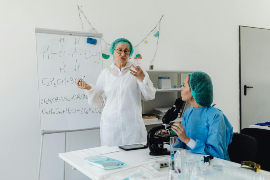Spotlights
Biology Professor, Life Science Instructor, Biological Sciences Lecturer, University Biology Faculty, Research Professor (Life Sciences), Assistant/Associate/Full Professor of Life Sciences, Molecular Biology Professor, Environmental Biology Professor, Plant Sciences Professor
If you’ve ever wondered why plants grow the way they do, how cells communicate, or what makes ecosystems work, Life Sciences Professors are the people who help uncover—and explain—those mysteries! These educators are part scientists, part mentors, and part explorers of the natural world.
Universities often describe life sciences as the study of “living systems and the processes that sustain them,” covering everything from molecular biology and genetics to ecology and evolution. Life Sciences Professors take that vast universe of knowledge and make it understandable and exciting for students who are just beginning their scientific journey.
In this role, professors dive deep into teaching subjects like microbiology, anatomy, biochemistry, botany, zoology, environmental science, and more. But teaching is only half the job. They’re also active researchers who design experiments, analyze data, publish findings, and push the boundaries of what we know about life on Earth. Their discoveries can contribute to cures for diseases, conservation strategies, agricultural innovations, and breakthroughs in biotechnology.
Life Sciences Professors work at universities, community colleges, and research institutions. Whether they’re lecturing in a packed classroom, guiding students through hands-on lab work, or presenting new research at scientific conferences, these professionals play a crucial role in shaping the next generation of scientists—and expanding our understanding of the living world.
- Inspiring students who may become future scientists, healthcare workers, conservationists, or educators.
- Conducting original research that can shape future scientific understanding.
- A flexible work environment where no two days look the same—part teaching, part research, part collaboration.
- Opportunities to travel, present at conferences, and contribute to global scientific conversations.
- The joy of making complex biology topics understandable and exciting for students.
Working Schedule
Life Science Professors typically work full-time during the academic year, often teaching several classes each week. Beyond scheduled lectures or labs, they spend time prepping lessons, advising students, writing papers, running experiments, and attending meetings.
Many professors also work early mornings or late evenings—especially when research deadlines, grant proposals, or exam weeks come around. Summers may be lighter on teaching but are often busy research seasons.
Typical Duties
- Develop and teach courses in biology, life sciences, and related fields.
- Lead lab sessions and guide students through hands-on experiments.
- Conduct independent or collaborative scientific research.
- Write and publish scientific papers, reports, and grant proposals.
- Mentor undergraduate and graduate students on academic and career pathways.
- Review assignments, grade exams, and provide student feedback.
- Stay updated on scientific advancements in their specialty area.
Additional Responsibilities
- Overseeing laboratory safety protocols.
- Managing research budgets, laboratory equipment, and grant funds.
- Participating in departmental meetings and committees.
- Advising student research groups or academic clubs.
- Representing the university at conferences or outreach events.
A Life Science Professor might begin the morning prepping slides for an 8:00 AM lecture on cell processes. After class, they meet with students during office hours—answering questions, reviewing research proposals, and offering academic guidance.
Midday might be spent in the lab checking on experiments, taking samples, or analyzing data with research assistants. Later in the afternoon, they may attend a faculty meeting or review a student’s draft thesis. By evening, they could be reading scientific literature, writing a grant proposal, or preparing tomorrow’s lab activities.
“Nothing in biology makes sense except in the light of evolution.” — Theodosius Dobzhansky
Soft Skills:
- Clear communication
- Patience
- Empathy
- Curiosity and continuous learning
- Strong organization
- Problem-solving
- Time management
- Collaboration
- Perseverance during long research phases
Technical Skills:
- Laboratory techniques (PCR, microscopy, culturing, etc.)
- Data analysis and scientific writing
- Research design and statistical methods
- Knowledge of safety protocols and lab management
- Grant writing
- Use of scientific software and databases
- Academic presentation and publication skills
- Teaching Professors / Lecturers – Focus mainly on instruction and student support.
- Research Professors – Spend most of their time conducting experiments and publishing.
- Tenure-Track Faculty – Balance teaching, research, and service responsibilities.
- Adjunct Professors – Part-time instructors often teaching specific courses.
- Specialized Faculty – Focus on areas like microbiology, ecology, plant sciences, marine biology, genetics, and more.
- Colleges and Universities
- Research Institutions
- Government Research Agencies
- Hospitals
- Medical Schools
- Biotechnology Companies
- Pharmaceutical Companies
- Scientific Societies and Professional Associations
Life Sciences Professors work in an environment that demands curiosity, stamina, and a genuine passion for teaching and research. While the role might look flexible from the outside, the reality is that balancing classroom responsibilities with ongoing scientific research can be challenging and time-consuming.
Scientific progress in academia rarely happens quickly. Research projects can span months or even years before producing publishable results, and many experiments fail before they succeed. Professors must learn to navigate these setbacks while continuing to mentor students, revise course materials, and keep up with new discoveries in their field.
The workload can be intense. During peak periods—like grading seasons, conference deadlines, or lab experiments—professors may put in long hours, including evenings and weekends. They often juggle multiple roles: instructor, researcher, advisor, committee member, and sometimes even department administrator. Each role comes with expectations that can pile up fast.
Securing research funding is another major pressure point. Grant writing can be repetitive and stressful, especially since funding is limited and competition is fierce. A single project may require multiple proposals before receiving approval, which means professors must constantly justify the value of their ideas while still managing their teaching load.
Despite these challenges, many Life Sciences Professors say the rewards—the breakthroughs in the lab, the excitement of students discovering new concepts, and the chance to contribute to scientific knowledge—make the sacrifices worthwhile.
- AI and automation in research: Professors are using artificial intelligence, machine learning, and automated lab tools to analyze massive biological datasets faster than ever before.
- Hands-on, inquiry-based teaching: Colleges are moving away from memorization-heavy courses and toward active learning, where students design experiments, analyze real data, and solve real-world problems.
- Growth of STEM equity and inclusion initiatives: Many life science departments are creating programs to support underrepresented students, making science more accessible and diverse.
- Global collaboration: Research is increasingly international, with professors partnering with labs around the world on shared projects—especially in climate science, epidemiology, and genomics.
- Sustainability-focused research funding: Governments and foundations are investing in research related to conservation, renewable energy, agriculture, and climate resilience.
- Remote and hybrid research tools: Cloud-based platforms now allow students and researchers to access data, run simulations, and collaborate even when they’re not physically on campus.
- Rise of citizen science: Professors are involving the public in large-scale data collection projects—such as wildlife counts, biodiversity tracking, and environmental monitoring.
- Entrepreneurship in science: More life science faculty are launching startups or partnering with biotech companies to bring scientific discoveries to the marketplace.
- Emphasis on communication skills: Universities are encouraging scientists to improve their ability to communicate research to the public, policymakers, and media.
- Ethical training in emerging technologies: With rapid advancements in gene editing, synthetic biology, and AI, professors are integrating bioethics discussions into their courses and research programs.
Future Life Science Professors often loved activities that sparked curiosity about nature and how things work. They might have enjoyed exploring tide pools, growing plants, caring for animals, building science fair projects, or watching STEM videos online. Many read books about wildlife, human biology, or space. Others spent time helping classmates understand homework or leading school science clubs.
These early interests usually reflect a desire to ask questions, experiment, observe patterns, and share knowledge with others—skills that become central to their future careers.
Becoming a Life Sciences Professor requires a strong academic foundation and many years of advanced training. Most professionals begin with a bachelor’s degree in biology, microbiology, biochemistry, environmental science, or another life science discipline. From there, almost all professors pursue graduate education, with a Ph.D. in a specific life sciences field—such as molecular biology, genetics, ecology, physiology, or microbiology—being the standard requirement for teaching and research positions at universities.
For those aiming to work at research-intensive institutions, postdoctoral research experience is typically essential. Postdocs allow emerging scientists to specialize further, publish scholarly papers, and gain experience running experiments, managing labs, and mentoring students—all skills that are crucial for securing a faculty position.
Common college courses for future Life Sciences Professors
include:
- Biochemistry
- Microbiology
- Genetics
- Cell and molecular biology
- Organic and general chemistry
- Ecology and evolution
- Biostatistics
- Physiology
- Research methods
- Bioinformatics
Hands-on laboratory experience is a major part of the training pathway. Students should pursue internships or research assistant positions in university labs, government research centers, field research programs, biotech companies, or environmental agencies. These opportunities build technical skills and provide exposure to real-world scientific inquiry.
Additional training that can strengthen a candidate’s academic career includes:
- Scientific writing and publishing workshops
- Teaching assistant (TA) training programs
- Field research certifications (e.g., wildlife handling, environmental sampling)
- Bioinformatics and data analysis courses
- Grant writing seminars
- Laboratory safety and compliance training
This long educational journey equips aspiring professors with the scientific expertise, research experience, and teaching skills needed to guide the next generation of students and contribute meaningful discoveries to the life sciences field.
- Take biology, chemistry, environmental science, and AP/IB science courses.
- Join science clubs, STEM competitions, or research programs.
- Volunteer or intern in labs, nature centers, clinics, or science museums.
- Build strong writing and communication skills—key for scientific papers and teaching.
- Participate in undergraduate research or lab assistant positions.
- Seek out mentors in biology or related fields.
- Attend science fairs, workshops, or summer research programs.
- Keep a portfolio of lab experience, research projects, and science presentations.
- Shadow a scientist, professor, or lab technician to understand what real research looks like.
- Join tutoring programs or become a peer mentor to build early teaching and communication skills.
- Work on independent science projects to practice forming hypotheses and analyzing data.
- Attend college seminars, guest lectures, or virtual talks hosted by science departments.
- Learn basic coding skills (Python or R), which are widely used in biological research.
- Strong biology or life sciences department with active research faculty.
- Opportunities for undergraduate and graduate research.
- Access to well-equipped labs, fieldwork opportunities, and modern technology.
- Programs that encourage publishing research or presenting at conferences.
- Teaching assistant (TA) positions to gain classroom experience.
- Faculty who are engaged in the areas you’re passionate about (genetics, ecology, molecular biology, etc.).
- Good career placement support and partnerships with research institutions.
- Availability of interdisciplinary courses in areas like bioinformatics, environmental science, or biotechnology.
- Strong mentorship programs that connect students with faculty, postdocs, and industry researchers.
- Access to grants, scholarships, or funded research opportunities for students at all levels.
- Create a strong academic CV and LinkedIn profile that highlight your research interests, lab experience, teaching roles, publications, and conference presentations.
- Build your network by attending biology conferences, academic seminars, and university events—these are great places to meet faculty, postdocs, and department chairs.
- Search for faculty openings on platforms like HigherEdJobs, Chronicle of Higher Education, LinkedIn, and university HR websites.
- Look for opportunities such as teaching assistantships, research assistant positions, adjunct instructor roles, or postdoctoral fellowships—these are common stepping-stones into full-time faculty jobs.
- Use keywords in your CV and cover letter related to your specialization, such as molecular biology, microbiology, ecology, genetics, cell culture, field research, or bioinformatics.
- Ask your dissertation advisor, research mentors, or postdoc supervisors for strong recommendation letters or permission to list them as professional references.
- Prepare for academic interviews by reviewing the department’s curriculum, reading recent papers from the faculty interviewing you, and understanding the school’s mission.
- Stay updated on current scientific trends, breakthrough research, and teaching methods that support inclusive, student-centered learning.
- Prepare and rehearse your teaching demonstration and research talk—both are standard parts of the hiring process.
- Dress professionally for campus interviews and be ready for full-day schedules, including meetings with faculty, students, and administrators.
Practice your responses for academic interview questions, such as:
- “How would you engage students in an introductory biology course with varying levels of science background?”
- “What is your long-term research agenda, and how does it align with our department’s goals?”
- “Describe a challenging research project you led. What did you learn from it?”
- “How do you create an inclusive lab or classroom environment for diverse learners?”
- Let your department chair or mentor know you’re interested in moving into higher academic roles such as tenure-track faculty, senior lecturer, department coordinator, or research program director.
- If you haven’t completed a postdoctoral fellowship, consider pursuing one to deepen your expertise and strengthen your publication record.
- Stay current with new scientific discoveries, research technologies, and advancements in your specialization—whether that’s genetics, ecology, microbiology, physiology, or molecular biology.
- Get comfortable with advanced laboratory techniques, field research tools, data analysis software, and bioinformatics platforms that are widely used in modern life sciences research.
- Publish consistently in peer-reviewed journals and present your work at conferences such as those hosted by the Society for Integrative and Comparative Biology, American Society for Microbiology, or Ecological Society of America.
- Develop strong mentorship skills by advising student researchers, supervising lab assistants, and serving on thesis committees.
- Build relationships with senior faculty, research directors, and other professionals who can mentor you and advocate for your advancement.
- Join professional organizations like the American Society for Biochemistry and Molecular Biology, National Association of Biology Teachers, or the American Institute of Biological Sciences to connect with experts and access training, grants, and leadership opportunities.
- Strengthen your grant-writing abilities—securing external funding is often essential for promotion, tenure, and independence as a researcher.
- Collaborate with researchers across departments, universities, or countries to broaden your research portfolio and increase the visibility of your work.
- Take on specialized research topics in your field, such as CRISPR applications in genetics, climate-driven ecosystem changes, microbial interactions, plant-soil dynamics, or cellular signaling pathways.
- Seek leadership opportunities within your department, such as curriculum development, committee service, or directing undergraduate or graduate programs.
- Aim for roles with growing responsibility, such as principal investigator (PI), research center associate director, or department chair.
- Attend workshops, seminars, and academic leadership programs to strengthen teaching and administrative skills while expanding your professional network.
Websites
- American Society for Biochemistry and Molecular Biology (ASBMB)
- American Society for Microbiology (ASM)
- Genetics Society of America (GSA)
- Society for Conservation Biology (SCB)
- Federation of American Societies for Experimental Biology (FASEB)
- American Physiological Society (APS)
- Association for the Sciences of Limnology and Oceanography (ASLO)
- Bioinformatics.org
- Public Library of Science (PLOS) – Open Access Journals
- ResearchGate – Research Collaboration Network
- Science Careers (by AAAS)
- Nature Careers
- BioSpace – Biotech Industry Jobs
- USAJOBS – Government Research and Academic Roles
- NIH Office of Intramural Training & Education (OITE)
- Coursera – Life Science Courses & Certifications
- edX – University-Level Biology and Research Courses
- Khan Academy – Biology Education Resources
- JSTOR – Academic Research Articles
- Google Scholar – Research Database
Books
- The Chicago Guide to College Science Teaching by Terry McGlynn
- Writing Science by Joshua Schimel
- How to Be a Scientist by Steve Mould
- The Scientist’s Guide to Writing by Stephen Heard
- Biology by Campbell & Reece (classic foundational text)
Life Sciences Professors play a crucial role in educating future scientists and expanding our understanding of living systems. But if this career doesn’t feel like the perfect match for you, there are many related pathways where you can still work with biology, research, and scientific discovery. Here are some alternative careers to consider:
- Research Scientist
- Laboratory Technician
- Science Writer or Editor
- Environmental Scientist
- Biotechnology Technician
- High School Biology Teacher
- Clinical Research Coordinator
- Museum or Science Center Educator
Newsfeed

Featured Jobs

Online Courses and Tools








